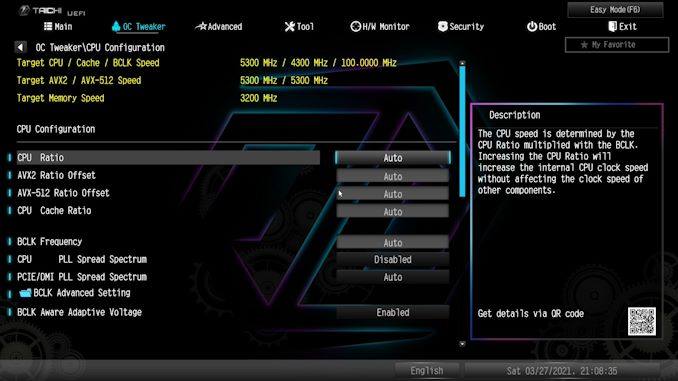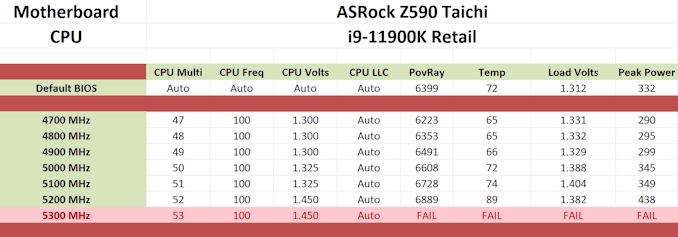ASRock Z590 Taichi Review: An Intel Motherboard with Moving Parts (and Thunderbolt 4)
by Gavin Bonshor on April 1, 2021 11:00 AM ESTOverclocking
Experience with the ASRock Z590 Taichi
Intel's latest Rocket Lake processors include plenty of benefits for novice and advanced users when it comes to overclocking. First of all, Intel has made further enhancements over its previous Comet Lake processors, which we had plenty of experience with for the majority of 2020. When overclocking with both Comet Lake and Rocket Lake, the core fundamentals remain much of the same, with Intel fine-tuning its secret sauce for the 11th gen K/KF series processors with its new Adaptive Boost Technology. Despite knowing the Intel specification to these limits with PL2 and Tau, we know motherboard vendors typically ignore these values implementing its own variations within the firmware, which generally go above and beyond what Intel deems appropriate.
Another important fact to consider when doing any form of overclocking is making sure that adequate cooling methods are used. It would be ineffective to try and run an Intel Core i9-11900K at 5.1 GHz all-core on a basic sub $30 air cooler, and common sense is key here. To squeeze out those last extra bits of frequency generally require the biggest jumps in CPU VCore, which in turn hikes up the power demands, and more power equals more heat, which needs to be tamed effectively.
Our experience with the ASRock Z590 Taichi when it came to overclocking was a pleasant one. In terms of usability, the ASRock Taichi UEFI firmware is simple to navigate, which is mainly down to the OC Tweaker section's organization. The three main variables for overclocking, including frequency, memory, and voltages, all sit within its own sections, making it easy to navigate and cumbersome for users to remember each value for each setting. To give an example of this, users that will be looking to overclock the CPU will need to frequent back and forth between the CPU configuration menu and voltage menus.
Users looking to overclock the memory or benefit from Intel's latest enhancements to memory overclocking can find all of the relevant settings in the memory configuration submenu. Here users can enable X.M.P 2.0 memory profiles on compatible memory kits at the click of a button, although users looking to tweak memory manually will need to adjust the memory (DRAM) voltage in the voltage submenu.
Overall depending on a user's preference, the ASRock Z590 Taichi firmware can be pleasing and infuriating at the same time. Having all the overclocking elements in separate submenus does tidy up the GUI and keep everything in its own place. For experienced overclockers, this won't be an issue, but to the more novice user who may be used to having the settings in a long list to help remember what they have set, it could provide a little headache. The Taichi UEFI firmware itself was responsive to both USB keyboard and mouse input, and it more than stable enough for launch.
Overclocking Methodology
Our standard overclocking methodology is as follows. We select the automatic overclock options and test for stability with POV-Ray and Prime95 to simulate high-end workloads. These stability tests aim to catch any immediate causes for memory or CPU errors.
For manual overclocks, based on the information gathered from the previous testing, start off at a nominal voltage and CPU multiplier, and the multiplier is increased until the stability tests are failed. The CPU voltage is increased gradually until the stability tests are passed. The process repeated until the motherboard reduces the multiplier automatically (due to safety protocol) or the CPU temperature reaches a stupidly high level (105ºC+). Our testbed is not in a case, which should push overclocks higher with fresher (cooler) air.
Overclocking Results
The ASRock Z590 Taichi is the first board we've overclocked with when using Intel's Core i9-11900K, and overall our experience was a positive one. Using our settings at default as the baseline, we know Rocket Lake runs warm, with a maximum temperature of 72ºC despite using one of Corsair's best 360 mm AIO coolers, the H150i Elite Capellix. Peak power draw also topped out at 332 W when running our POV-Ray benchmark, which is quite intensive on both the compute and memory elements.
Running our testing at manual settings, we started out at 4.7 GHz all-core with 1.3 V on the CPU VCore, which equated to a CPU VCore load voltage of 1.331 V, which is around a 2.3% bump in voltage. When altering the CPU VCore variable within the firmware, it's worth noting that it automatically applies the Level 1 LLC profile, which is quite aggressive but also ensures there's enough voltage compensation available for voltage stuttering. Going up from 4.7 GHz to 5.2 GHz, which was the maximum overclock all-core we could achieve, performance in our POV-Ray benchmark increased, along with heat and power requirements. At 5.2 GHz, we managed to pull an impressive peak wattage of 438 W, which considering the i9-11900K is an eight-core CPU, is slightly concerning when directly compared to AMD's parts.
Overall the Z590 Taichi had adequate, albeit aggressive VDroop control, especially at 1.325 V in the firmware, which translated from between 1.388 and 1.404 V at full-load. Although this is slightly concerning behavior, we do expect ASRock to balance this out as its firmware matures over time.












50 Comments
View All Comments
Cullinaire - Thursday, April 1, 2021 - link
What a gimmick. Instead of a stepper motor why not have a steam engine powered by the CPU heat.Molor1880 - Thursday, April 1, 2021 - link
Should have gone with a tiny sterling engine. That would make this joke a bit better.kachan64 - Friday, April 2, 2021 - link
Agree. Should have gone with that!YB1064 - Friday, April 2, 2021 - link
No 10GbE on a FOUR HUNDRED dollar motherboard?? No thanks.zanon - Saturday, April 3, 2021 - link
This, the money they put into the gimmick useless juno should have gone to networking instead. Though I suppose in fairness unlike AMD they have to work with severe bandwidth limitations so they can't just do every single useful feature. But that one should have been a priority.ZoZo - Saturday, April 3, 2021 - link
There's the same bandwidth on the Z590 platform as the X570.20 PCI-E 4.0 lanes from the CPU, and ~4 GB/s between CPU and chipset (through 4 PCI-E 4.0 lanes on X570, and 8 DMI/PCI-E 3.0 lanes on Z590).
And 10 Gb/s networking just needs 1.25 GB/s, so no severe bandwidth limitations from connecting it to a PCI-E 3.0 x1 link to the chipset.
TheinsanegamerN - Sunday, April 4, 2021 - link
The raichu line had 10gb as a selling point with the z200 and x400 vhipsets. For some reason asrock abandoned this idea and raised the price.TheinsanegamerN - Sunday, April 4, 2021 - link
Agreed. The whole reason to get a taichi was the 10gb ethernet onboard.Samus - Saturday, April 3, 2021 - link
This is about the level of gimmick I expected from ASRock, after all the brand is a second-rate Asus so they need to do these cheesy things to get attention.zotric - Sunday, October 10, 2021 - link
I must say I have had excellent support for my older ASRock Taichi board so don't write it off!